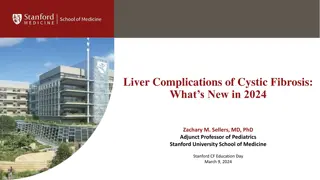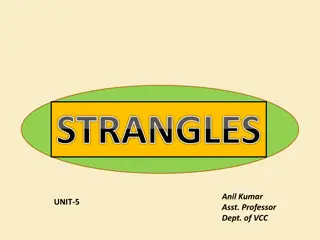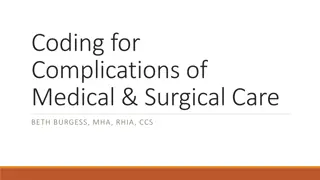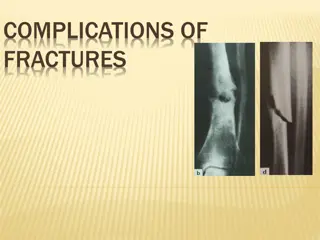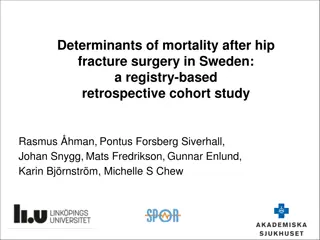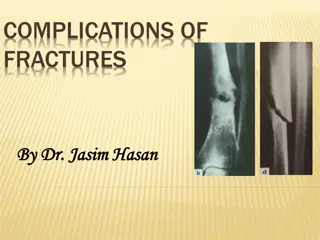Complications One Year After Mid-Urethral Slings in Sweden
This study aims to provide a quantitative analysis of patient-reported complications one year after mid-urethral slings in Sweden. The GynOp register covers all Swedish surgeries with a high coverage and patient response rate. The study, led by Stefan Zacharias and Eva Uustal, looks into complications, patient materials, definitions of serious complications, and main types of complications like disturbed micturition. The results show that a significant number of women reported some complications or dissatisfaction post-surgery.
Download Presentation

Please find below an Image/Link to download the presentation.
The content on the website is provided AS IS for your information and personal use only. It may not be sold, licensed, or shared on other websites without obtaining consent from the author.If you encounter any issues during the download, it is possible that the publisher has removed the file from their server.
You are allowed to download the files provided on this website for personal or commercial use, subject to the condition that they are used lawfully. All files are the property of their respective owners.
The content on the website is provided AS IS for your information and personal use only. It may not be sold, licensed, or shared on other websites without obtaining consent from the author.
E N D
Presentation Transcript
Complications one year after mid urethral slings in Sweden: the womens descriptions classified Stefan Zacharias, MD Hudiksvall Eva Uustal, MD, PH D Link ping
Conflict Conflict of of intrest intrest Stefan Zacharias is the register manager for incontinence, GynOp Eva Uustal is the register manager for perineal tears and prolapse, GynOp The study is financed by the GynOp register
What is the Gyn Op register? The register covers all Swedish surgeries Coverage 90 %, patient response rate >90% Complete surgical data PROM, PREM Preop, after 8 weeks and after one years All patient-reported data are presented to the surgeon who performed the surgery
Aim of the study To give a quantitative description of patient reported complications at the one year survey for mid urethral slings in Sweden.
Patient material, 2017 4160 cases, 60% TVT, 20% TOT, 20% TVT-0 681 women - 16%-reported either some complication, feeling worse then before, or being unhappy with result 578 out of these 681 women (85%) used the possibility to comment on their problem in their own words.
Definitions Definitions of of serious GynOP GynOP, , examples serious complication complication examples Obvious complication: Injury, handicap or death caused by surgery Readmittance to hospital more than one night Sick leave longer than one month Complications subject to interpretation: Repeat surgery Organ dysfunction with evident/daily reduction of quality of life
Main Main types types of of complications complications 250 200 150 100 50 0 Serie 1
Disturbed Disturbed micturition micturition, , detailed detailed analysis analysis Painful micturition Urinary incontinence Urinary retention Impaired emptying Urgency 0 10 20 30 40 50 60 70 80 90
Pain, detailed analysis Constant chronic pelvic pain Painful micturition Abdominal pain Wound pain Dyspareunia Groin pain 0 10 20 30 40 50 60 70 80 90 100
Infection Serie 1 Unknown, antibiotics treatment Septicemia Wound infection Vaginosis UTI 0 10 20 30 40 50 60 70 80 Serie 1
Hemorrhage Hemorrhage Vaginal hemorrhage Intraabdominal bleeding - laparotomy Hematoma 0 0.5 1 1.5 2 2.5 3 3.5 4 4.5
Organ damage Urethra Bladder Nerve damage (sensory loss) Vaginal mesh erosion 0 5 10 15 20 25 30 35
General complications DVT TIA (6 day care on stroke unit) Pruritus
Persistant discomfort due to surgery authors interpretation Persistant discomfort: 408 No problems: 130 Unclear if related to surgery: 21 Not related to surgery: 19 Persistant discomfort No problems Discomfort but unclear if related to surgery Discomfort but not related to surgery
Discrepancies Discrepancies in interpretation in interpretation of of complication complication 83 338 SURGEONS 13 144 15 52 AUTHORS 102 409 0 3 WOMEN 96 479 0 100 200 300 400 500 600 Unclear / not evaluated by surgeon No complication Serious complication Minor complication
Complications due to incontinence surgery are more common than generally anticipated. 10% of women experience persisting discomfort one year after incontinence surgery Surgeons seem to often disregard womens opinion about complications. The reasons for this remains to be studied. Conclusions Conclusions
THANK YOU FOR YOUR ATTENTION



